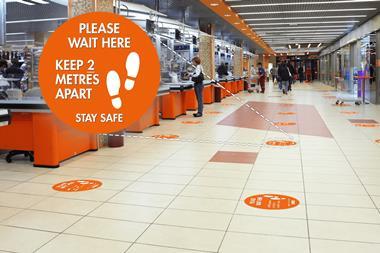As government directives are gradually relaxed, essential and non-essential retailers require flexibility to quickly adapt, implement and communicate ongoing safety measures says OKI Europe’s head of vertical solutions, Javier Lopez.
It’s been a challenging time for retailers, with the majority forced to either close or completely rethink their operations.
As the Covid-19 rate of infection (R) begins to flatten out across Europe, governments are starting to incrementally lift lockdown measures. However, it is highly unlikely that life will return to the normality we all knew before current restrictions came into effect.
Following the economic disruption posed by the pandemic, governments and retailers will be keen to get back to ‘business as usual’. Yet retailers should expect to adhere to specific government-issued guidelines to help avoid a further surge in Covid-19 cases spreading and potentially leading to a second lockdown.
A phased approach of this kind could include staff and customers wearing face masks, as well as managing footfall by setting shopping time limits and adhering to social distancing measures inside stores.
Addressing a completely new set of challenges
OKI Europe’s whitepaper on The Benefits of In-store Signage in a Crisis highlights how in-store visual communications are critical to helping retailers adhere to changing government regulations.
For example, retailers that have been forced to keep their premises closed during lockdown will be keen to open the doors and gain customer footfall once more. However, they will need to ensure their store complies to all government directives associated with protecting the wellbeing of staff and customers and stopping the virus spreading further.
This includes floor stickers for social distancing, window stickers communicating changes in store opening times, hanging and freestanding banners to help shoppers navigate quickly and safely, and shelf signage to highlight restrictions on purchases and stock availability.
Essential retailers such as grocers, supermarkets and pharmacies that have been allowed to remain open have already confronted the challenge of putting clear in-store communications in place.
But they all face the fresh challenge, alongside non-essential retailers, of adapting to continually changing guidelines and measures, and ensuring any changes are reflected and communicated immediately in their stores.
Improving agility with in-store printing
When it comes to changing signage in-store on a frequent basis, retailers typically lack speed and agility. They are often limited by the availability of in-store resources, relying heavily on the services of third-party print suppliers or teams located at head office and waiting for urgent signage to be delivered, resulting in long lead times and the inability to change signage on the fly – a necessary requirement during these testing times.
For retailers, these weeks and months are critical – time is money. Forward-thinking retailers are taking steps to prepare for reopening by enabling the printing of urgent signage in-store.
Compact printers that are designed specifically for in-store use can handle a variety of media, formats and finishes, in high-definition colour and in the professional quality you would expect from a print supplier.
Recognising that it can be challenging for businesses to create and implement vital social distancing signage quickly, OKI Europe is offering retailers free* media and artwork to create self-adhesive floor stickers that can be printed quickly and easily. This will enable those retailers in the process of reopening after enforced closures to become operational while protecting the wellbeing of staff and customers.
Keeping staff and customers safe post-lockdown
As we eventually come out of this crisis, flexibility will be key and retailers will need to change and update signage quickly as guidance develops.
Ongoing supply chain issues could also mean that certain product ranges are absent from the shelves or purchasing restrictions are still set in place. In this scenario, smaller-format signage such as shelf labels highlighting purchasing limits and stock availability are perfect for informing customers about shortages and lead times. The same format of signage adorned with graphics can also be used to direct customers’ attention towards alternative products.
Therefore, when it comes to preparing stores to open post-lockdown, retailers should consider having this flexibility to print signage in-store. By putting in place the right technology now, retailers can ensure they are operational quickly and safely during the gradual journey to the new normal.

Javier Lopez is OKI Europe Ltd’s head of industry vertical solutions.
Download OKI Europe’s whitepaper on The Benefits of In-store Signage in a Crisis.































